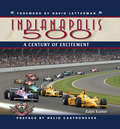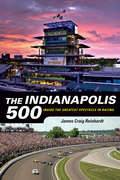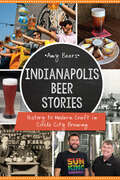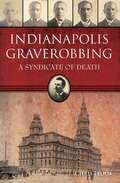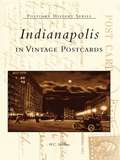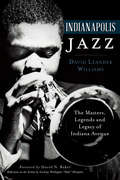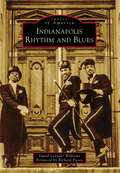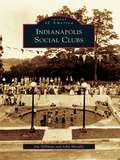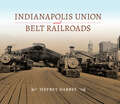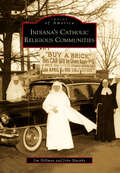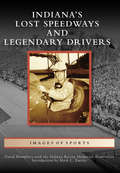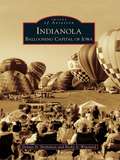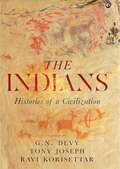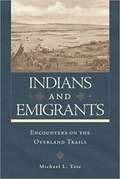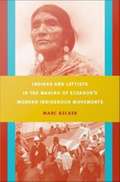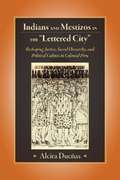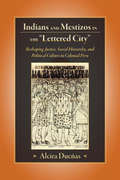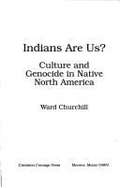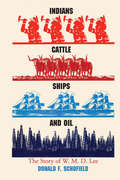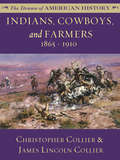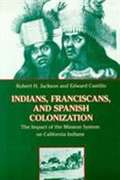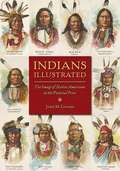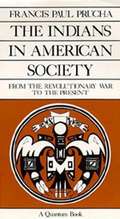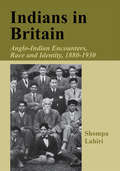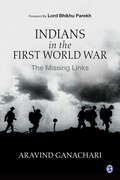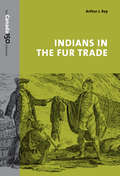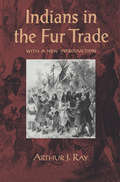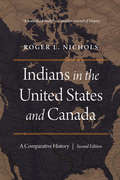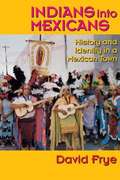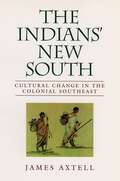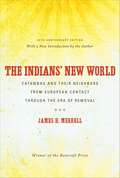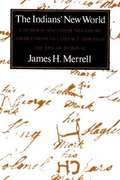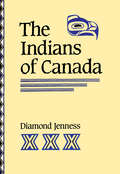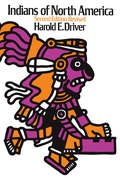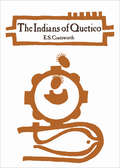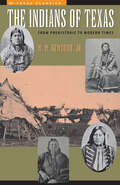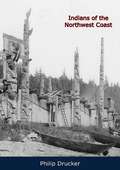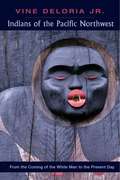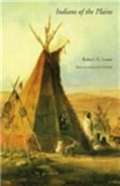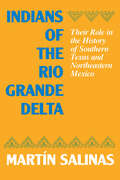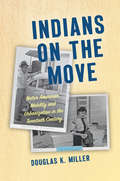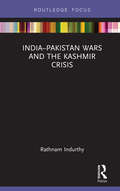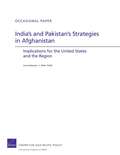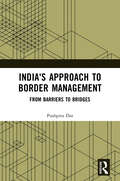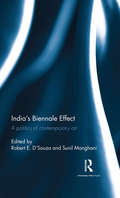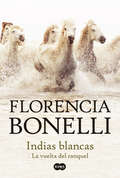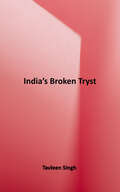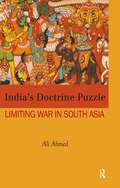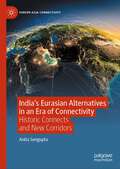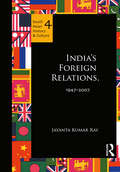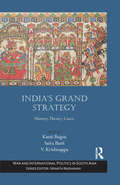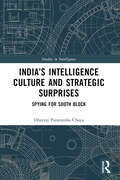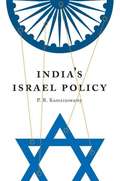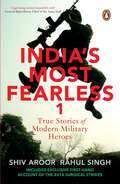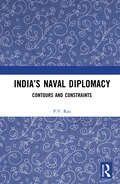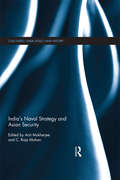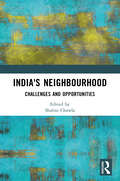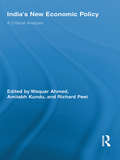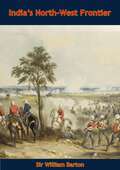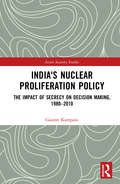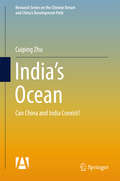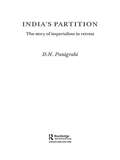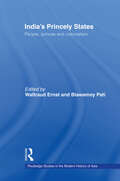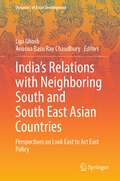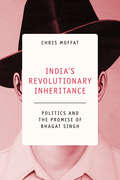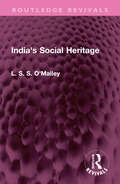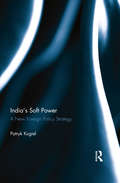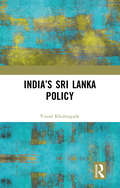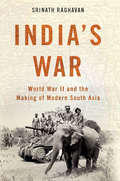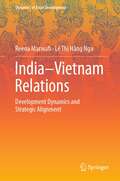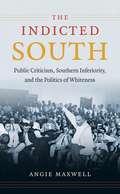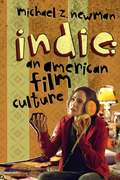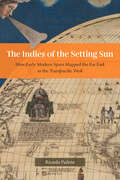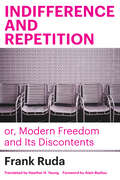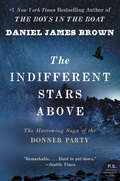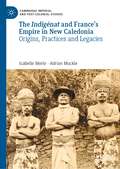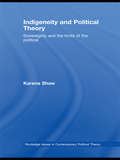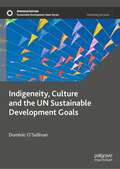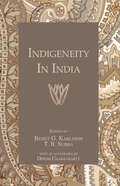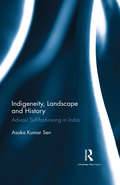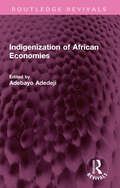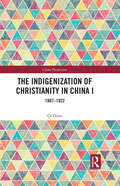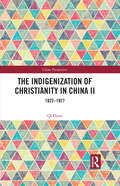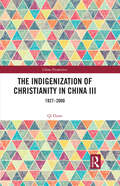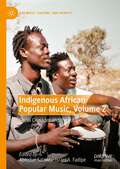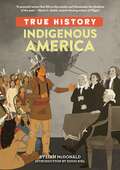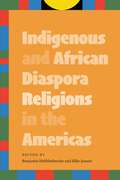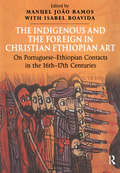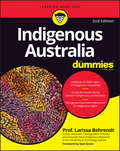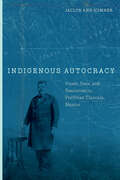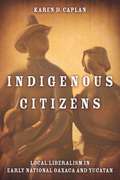- Table View
- List View
The Indianapolis 500: A Century of Excitement
by Ralph KramerThe Greatest Spectacle in RacingSince the dawn of automotive racing, the world's best drivers have tested their skills, bravery and the limits of speed in the legendary Indianapolis 500. The winner claims the historic Borg-Warner Trophy, and racing immortality.Officially licensed in cooperation with the Indianapolis Motor Speedway, Indianapolis 500: A Century of Excitement tells the compelling and entertaining story of the race that has become known as simply "The Greatest Spectacle in Racing." Overflowing with photographs hand-picked from the Speedway's mammoth photo archives, and filled with historic, behind-the-scene stories, you'll revel in the history that has shaped this amazing event.
The Indianapolis 500: Inside the Greatest Spectacle in Racing
by James Craig ReinhardtKnown as the "Greatest Spectacle in Racing," the Indy 500 humbly began in 1911. Labeled as the first speedway, this two-and-a-half-mile oval is now home to many of today's top races, including the Brickyard 400, the Verizon IndyCar Series, the Monster Energy NASCAR Cup Series, the SportsCar Vintage Racing Association, the Red Bull Air Race World Championship, and its most famous race, the Indianapolis 500. In The Indianapolis 500: Inside the Greatest Spectacle in Racing, speedway tour guide and racing aficionado James Craig Reinhardt shares what makes the legendary racetrack special. He reveals the speedway's unbelievable history, fast-flying action, notorious moments, and its secrets, including facts about the beginning of the brickyard, why the drivers kiss the finish line, how milk became the drink of choice, and much more. The perfect gift for the veteran or rookie, The Indianapolis 500 is a must-have for all race fans.
Indianapolis Beer Stories: History to Modern Craft in Circle City Brewing (American Palate)
by Amy BeersIndianapolis Beer Stories is a time capsule of tales from the city's early taverns, to a pre-Prohibition golden era, to today's modern craft beer scene.Meet the ghosts of Indy's brewing past. Discover the very beginning of beer in Indiana's new capital and the pioneers who carved a path for a future industry. Uncover the legacy of a bygone brewing giant. Learn how one spontaneous decision to cross the treacherous Rocky Mountains led to a booming craft beer scene in Indiana.Indiana native Amy Beers, a Certified Cicerone® and owner/operator of Drinking with Beers, leads a heady tour of yesterday and today in Circle City brewing.
Indianapolis Graverobbing: A Syndicate of Death (True Crime)
by Chris FlookSurveying the sensational newspaper accounts as events unfolded, author and historian Chris Flook recounts this grisly tale of political intrigue and conspiracy. In the fall of 1902, Indianapolis police uncovered a prolific graverobbing ring operating across the city. At the time, cemeteries across central Indiana were relieved of their dead by ghouls, as they were called, seeking fresh corpses desperately needed by the city's medical colleges. The ring was also accused of multiple murders. In Hamilton County, a former Confederate soldier named Wade West delivered stolen corpses by floating them down the White River. His counterpart in Indianapolis, Rufus Cantrell, an itinerant preacher and full-time graverobber known as the "King of the Ghouls," ransacked Indy's cemeteries for years before being caught.
Indianapolis in Vintage Postcards (Postcard History)
by W. C. MaddenIn the late 1800s, postcards of Indianapolis began appearing in mailboxes throughout the country. Since that time, the many prominent monuments, buildings, and parks of the Hoosier capital have been featured on countless cards.Using an impressive collection of these images, author W.C. Madden takes the reader on an historic journey through Indianapolis from 1890 to 1950, providing a visual history of the development of the city. Indianapolis experienced great growth during the first half of the 20th century, which gave rise to innovative art and architectural structures, many that serve as the subject of postcards featured here. The Soldiers and Sailors Monument, the Indiana World War Memorial, the Indianapolis Motor Speedway, Union Station, and Claypool Hotel, to name a few, are all highlighted.
Indianapolis Jazz: The Masters, Legends and Legacy of Indiana Avenue (Music Ser.)
by David N. Baker David Leander WilliamsGet into the music with David Leander Williams as he charts the rise and fall of Indiana Avenue, the Majestic Entertainment Boulevard of Indianapolis, which produced some of the nation's most influential jazz artists. The performance venues that once lined the vibrant thoroughfare were an important stop on the Chitlin' Circuit and provided platforms for greats like Freddie Hubbard and Jimmy Coe. Through this biography of the bustling street, meet scores of the other musicians who came to prominence in the avenue's heyday, including trombonist J.J. Johnson and guitarist Wes Montgomery, as well as songwriters like Noble Sissle and Leroy Carr.
Indianapolis Rhythm and Blues (Images of America)
by David Leander WilliamsIndiana Avenue was traditionally the host to some of America's premier, world-renown entertainment icons in various genres. Along this winding, brightly lit thoroughfare were nightclubs, lounges, supper clubs, taverns, juke joints, and holes-in-the-wall that celebrated the best of the best in entertainment that America had to offer, from the 1920s on into the 1970s. On the bandstand at Denver Ferguson's Sunset Terrace Ballroom, the elegantly attired crooner Nat King Cole, in a sparkling blue silk suit, delivered his signature song "Mona Lisa." Nearby, B.B. King sang his 1973 down-home blues classic "To Know You is to Love You." At Tuffy Mitchell's Pink Poodle nightclub, "Moms" Mabley made the audience roar with laughter during her sidesplitting comedy routine. Indiana Avenue truly was the place to be for the best in entertainment.
Indianapolis Social Clubs (Images of America)
by John Murphy Jim HillmanMore than banquet halls, golf courses, and swimming pools, social clubs were a haven for businessmen, politicians, and community leaders, offering respite from public scrutiny. Defining Indianapolis, the clubs were stoic agents of power and segregation, providing clear historical snapshots of Hoosier pomp and circumstance. The clubs did more than produce Olympic swimmers, world-class golfers, and tennis professionals; they were Indianapolis's multigenerational playgrounds. There were the politics and business dealings at the Columbia Club and the Indianapolis Athletic Club, the golfing, tennis, and formality of Woodstock, Meridian Hills, and other country clubs, and the family fun in the sun at Riviera, Devon, and Olympia. These organizations offered more than magical summers with family and friends; they were the places to be seen.
Indianapolis Union and Belt Railroads (Railroads Past and Present)
by Jeffrey DarbeeIn an era dominated by huge railroad corporations, Indianapolis Union and Belt Railroads reveals the important role two small railroad companies had on development and progress in the Hoosier State. After Indianapolis was founded in 1821, early settlers struggled to move people and goods to and from the city, with no water transport nearby and inadequate road systems around the state. But in 1847, the Madison & Indianapolis Railroad connected the new capital city to the Ohio River and kicked off a railroad and transportation boom. Over the next seven decades, the Indiana railroad map expanded in all directions, and Indianapolis became a rail transport hub, dubbing itself the "Railroad City." Though the Pennsylvania and the New York Central Railroads traditionally dominated the Midwest and Northeast and operated the majority of rail routes radiating from Indianapolis, these companies could not have succeeded without the two small railroads that connected them. In the downtown area, the Indianapolis Union Railway was less than 2 miles long, and out at the edge of town the Belt Railroad was only a little over 14 miles. Though small in size, the Union and the Belt had an outsized impact, both on the city’s rail network and on the city itself. It played an important role both in maximizing the efficiency and value of the city’s railroad freight and passenger services and in helping to shape the urban form of Indianapolis in ways that remain visible today.
Indiana's Catholic Religious Communities
by Jim Hillman John MurphyWith expanding Irish, Swiss, French, and German immigrant populations, the state of Indiana evolved from individual explorers, trappers, hunters, and traders into family-focused communities of farmers and craftsmen. Emerging from the former Indiana Territory, the state's early population was in need of education, health care, and social services to assist young families, the poor, the infirm, and the elderly. These needs were frequently met by Catholic religious orders, including the Benedictines, Sisters of Providence, Franciscans, Daughters of Charity, and other established organizations of dedicated religious men and women.
Indiana's Lost Speedways and Legendary Drivers (Images of Sports)
by David HumphreyFrom the Indianapolis 500 Motor Speedway to the dirt oval tracks in small Indiana towns, thousands of Hoosiers frequent the raceway of their choice each year. Today, there are an estimated 40 asphalt, clay, and dirt-covered oval tracks in Indiana where race fans cheer local drivers, often navigating jalopies pieced together from junkyard parts, to victory lane. Though many racetracks remain in operation throughout the state, dozens have fallen to the wayside over the past 100 years. Forever in remembrance are the famous and not so famous Indiana-born drivers who thrilled fans at those now defunct tracks. Evansville native Charlie Wiggins won the Gold and Glory Sweepstakes four times. Bob Kinser from Bloomington raced over 40 years and is an inductee of the National Sprint Car Hall of Fame, and Tom Cherry of Muncie won the Little 500 four times.
Indianola: Ballooning Capital of Iowa (Images of Aviation)
by Dennis D. Nicholson Becky S. WigelandIndianola, founded in 1849, is the county seat of Warren County, Iowa. It is located 12 miles south of Iowa's capital, Des Moines, at the intersection of U.S. highways 65 and 69 and state highway 92. The city is home of the National Balloon Museum, begun in 1972; the National Balloon Classic, an annual nine-day balloon rally; the Balloon Federation of America's national office; Simpson College; the Des Moines Metro Opera, a widely acclaimed summer opera festival; and is host to the Iowa Wine Festival each summer. This book focuses on the history of ballooning in Indianola, which hosted the U.S. National Hot Air Balloon Championships from 1970 to 1988, and the National Balloon Classic from 1989 to the present. This is the story of how Indianola became the ballooning capital of Iowa.
The Indians: Histories of a Civilization
by G N Devy Ravi Korisettar Tony JosephThe Indians is one of the most ambitious projects yet undertaken to map the origins, evolution, and present-day reality of India's civilization and people. Written by over one hundred of South Asia's foremost scholars and domain experts, the essays in the book cover a period of some 12,000 years-from the last Ice Age to the twenty-first century. <p><p>The book is divided into seven sections. The first part looks at the evolution of humans in South Asia through the lens of the early 'Indian' population, their migrations, and the climate. The second part focuses on the emergence of different civilizations in the region through the domestication of plants and animals and other factors and how these civilizations eventually begin to decline. The third part discusses the languages and philosophies that defined ancient India-Buddhism, Jainism, Sanskrit, Indo-Iranian languages, and Pali literature, among others. The fourth part is a detailed study of society and culture in various geographical regions--the North, South, Northeast, the Deccan, East, and West India. The fifth part looks at the advent of colonialism and its impact on the country's economy, social fabric, and knowledge systems. The sixth part looks at Adivasi movements, Ambedkarite politics, Gandhian resistance, and other events that would come to form the bedrock of the independent republic. And, finally, the seventh part looks at contemporary India--the workings of the Constitution and urbanism, liberalization, and other aspects of the modern Indian experience. <p><p>Taken together, the essays in the book provide remarkable insights into Indian history and society.
Indians and Emigrants: Encounters on the Overland Trails
by Michael L. TateIn the first book to focus on relations between Indians and emigrants on the overland trails, Michael L. Tate shows that such encounters were far more often characterized by cooperation than by conflict. Having combed hundreds of unpublished sources and Indian oral traditions, Tate finds Indians and Anglo-Americans continuously trading goods and news with each other, and Indians providing various forms of assistance to overlanders. <P><P> Tate admits that both sides normally followed their own best interests and ethical standards, which sometimes created distrust. But many acts of kindness by emigrants and by Indians can be attributed to simple human compassion. <P><P> Not until the mid-1850s did Plains tribes begin to see their independence and cultural traditions threatened by the flood of white travelers. As buffalo herds dwindled and more Indians died from diseases brought by emigrants, violent clashes between wagon trains and Indians became more frequent, and the first Anglo-Indian wars erupted on the plains. Yet, even in the 1860s, Tate finds, friendly encounters were still the rule. <P><P> Despite thousands of mutually beneficial exchanges between whites and Indians between 1840 and 1870, the image of Plains Indians as the overland pioneers’ worst enemies prevailed in American popular culture. In explaining the persistence of that stereotype, Tate seeks to dispel one of the West’s oldest cultural misunderstandings.
Indians and Leftists in the Making of Ecuador's Modern Indigenous Movements
by Marc BeckerIn June 1990, Indigenous peoples shocked Ecuadorian elites with a powerful uprising that paralyzed the country for a week. Militants insisted that the government address Indigenous demands for land ownership, education, and economic development. This uprising was a milestone in the history of Ecuador's social justice movements, and it inspired popular organizing efforts across Latin America. While the insurrection seemed to come out of nowhere, Marc Becker demonstrates that it emerged out of years of organizing and developing strategies to advance Indigenous rights. In this richly documented account, he chronicles a long history of Indigenous political activism in Ecuador, from the creation of the first local agricultural syndicates in the 1920s through the galvanizing protests of 1990. In so doing, he reveals the central role of women in Indigenous movements and the history of productive collaborations between rural Indigenous activists and urban leftist intellectuals. Becker explains how rural laborers and urban activists worked together in Ecuador, merging ethnic and class-based struggles for social justice. Socialists were often the first to defend Indigenous languages, cultures, and social organizations. They introduced rural activists to new tactics, including demonstrations and strikes. Drawing on leftist influences, Indigenous peoples became adept at reacting to immediate, local forms of exploitation while at the same time addressing broader underlying structural inequities. Through an examination of strike activity in the 1930s, the establishment of a national-level Ecuadorian Federation of Indians in 1944, and agitation for agrarian reform in the 1960s, Becker shows that the history of Indigenous mobilizations in Ecuador is longer and deeper than many contemporary observers have recognized.
Indians and Mestizos in the "Lettered City"
by Alcira DuenasThrough newly unearthed texts virtually unknown in Andean studies, Indians and Mestizos in the "Lettered City" highlights the Andean intellectual tradition of writing in their long-term struggle for social empowerment and questions the previous understanding of the "lettered city" as a privileged space populated solely by colonial elites. Rarely acknowledged in studies of resistance to colonial rule, these writings challenged colonial hierarchies and ethnic discrimination in attempts to redefine the Andean role in colonial society. Scholars have long assumed that Spanish rule remained largely undisputed in Peru between the 1570s and 1780s, but educated elite Indians and mestizos challenged the legitimacy of Spanish rule, criticized colonial injustice and exclusion, and articulated the ideas that would later be embraced in the Great Rebellion in 1781. Their movement extended across the Atlantic as the scholars visited the seat of the Spanish empire to negotiate with the king and his advisors for social reform, lobbied diverse networks of supporters in Madrid and Peru, and struggled for admission to religious orders, schools and universities, and positions in ecclesiastic and civil administration. Indians and Mestizos in the "Lettered City" explores how scholars contributed to social change and transformation of colonial culture through legal, cultural, and political activism, and how, ultimately, their significant colonial critiques and campaigns redefined colonial public life and discourse. It will be of interest to scholars and students of colonial history, colonial literature, Hispanic studies, and Latin American studies.
Indians and Mestizos in the "Lettered City": Reshaping Justice, Social Hierarchy, and Political Culture in Colonial Peru
by Alcira Duenas Alcira DueñasThrough newly unearthed texts virtually unknown in Andean studies, Indians and Mestizos in the "Lettered City" highlights the Andean intellectual tradition of writing in their long-term struggle for social empowerment and questions the previous understanding of the "lettered city" as a privileged space populated solely by colonial elites. Rarely acknowledged in studies of resistance to colonial rule, these writings challenged colonial hierarchies and ethnic discrimination in attempts to redefine the Andean role in colonial society. Scholars have long assumed that Spanish rule remained largely undisputed in Peru between the 1570s and 1780s, but educated elite Indians and mestizos challenged the legitimacy of Spanish rule, criticized colonial injustice and exclusion, and articulated the ideas that would later be embraced in the Great Rebellion in 1781. Their movement extended across the Atlantic as the scholars visited the seat of the Spanish empire to negotiate with the king and his advisors for social reform, lobbied diverse networks of supporters in Madrid and Peru, and struggled for admission to religious orders, schools and universities, and positions in ecclesiastic and civil administration. Indians and Mestizos in the "Lettered City" explores how scholars contributed to social change and transformation of colonial culture through legal, cultural, and political activism, and how, ultimately, their significant colonial critiques and campaigns redefined colonial public life and discourse. It will be of interest to scholars and students of colonial history, colonial literature, Hispanic studies, and Latin American studies.
Indians Are Us?: Culture and Genocide in Native North America
by Ward ChurchillChurchill sets out to expose those who would appropriate native culture and turn it into a commodity to be bought and sold. He reviews books and movies which have historical inaccuracies and which perpetuate stereotypes. Other essays deal with the issue of products and sports teams and the impact of government definitions of who is and is not Indian.
Indians, Cattle, Ships, and Oil: The Story of W. M. D. Lee
by Donald F. SchofieldIndian trader, rancher, harbor developer, oil impresario—these are the many worlds of one of the least chronicled but most fascinating characters of the American West. In the early, bustling years of the frontier, a brazen young man named William McDole Lee moved from Wisconsin to Kansas and then to Texas to forge a life for himself. Becoming a driving entrepreneurial force in Texas's development, Lee soon garnered the alliances and resources necessary to shape the financial destinies of disparate groups throughout the state. His story is expertly told in Donald F. Schofield's Indians, Cattle, Ships, and Oil. Beginning in 1869 as a trader to the southern Cheyenne and Arapaho tribes and fort provisioner to troops garrisoned at Camp Supply, Indian Territory, Lee gained a partner and amassed a fortune in short order from trading buffalo hides and robes. Vast herds of buffalo grazing on the southern plains were killed largely on his order. When buffalo were no longer a profitable commodity, Lee tackled his next challenge—the cattle trade. He began with herds branded LR that grazed on pastures near Fort Supply. Then came his LE herd in the Texas Panhandle. Another partnership, with noted cattle rancher Lucien Scott, resulted in the vast LS ranch, one of the most successful operations of its day. Lee even introduced a new breed of cattle, the Aberdeen-Angus, to the western range. But as his partnership faded, Lee moved on to his next undertaking—the development of Texas' first deep-water harbor. In 1888, Lee and other financiers put up one million dollars to finance a dream: opening international trade from the waters of the Gulf of Mexico to the mainland at the mouth of the Brazos River. Their Brazos River Channel and Dock Company was to construct, own, and operate a deep-water harbor at Velasco, with a railroad link to Houston. Though threats of financial disaster loomed large, the Velasco facility was to welcome, in its day, tugs, barges, and three-masted schooners and to provide impetus for Houston's boom. Yet with success, the mercurial Lee turned to yet another challenge—oil. Starting still another partnership, Lee committed himself to prospecting for oil on the West Columbia Ridge in Brazoria County. Lee and crew struck oil in 1907, developing one of the first producing wells of Brazoria County, but inadequate drilling equipment hampered further fruitful exploration. Lee moved his rigs to the famed Spindletop, where he perfected the technique of shallow drilling. Though spectacular success in the oil business eluded him, Lee's accomplishments set him squarely among the great entrepreneurs of the Texas oil industry. Lee's exploits led him to roles in some of the most dramatic moments in Texas and the West—Indian uprisings, buffalo hunts, political scandals, cowboy strikes and shoot-outs, railroad promotions, oil-well blow-outs and gushers. The people he encountered are the famous and infamous of western history: Cheyenne Chief Little Robe and the outlaw "Hurricane Bill" Martin; Indian Agent John D. Miles and Major General John Pope; outlaws Tom Harris and William Bonney, and Sheriff Pat Garrett. Altogether, Lee's biography vividly shows one man's manipulation of people and events during the settlement of the American frontier.
Indians, Cattle, Ships, and Oil: The Story of W. M. D. Lee
by Donald F. SchofieldIndian trader, rancher, harbor developer, oil impresario—these are the many worlds of one of the least chronicled but most fascinating characters of the American West. In the early, bustling years of the frontier, a brazen young man named William McDole Lee moved from Wisconsin to Kansas and then to Texas to forge a life for himself. Becoming a driving entrepreneurial force in Texas's development, Lee soon garnered the alliances and resources necessary to shape the financial destinies of disparate groups throughout the state. His story is expertly told in Donald F. Schofield's Indians, Cattle, Ships, and Oil. Beginning in 1869 as a trader to the southern Cheyenne and Arapaho tribes and fort provisioner to troops garrisoned at Camp Supply, Indian Territory, Lee gained a partner and amassed a fortune in short order from trading buffalo hides and robes. Vast herds of buffalo grazing on the southern plains were killed largely on his order. When buffalo were no longer a profitable commodity, Lee tackled his next challenge—the cattle trade. He began with herds branded LR that grazed on pastures near Fort Supply. Then came his LE herd in the Texas Panhandle. Another partnership, with noted cattle rancher Lucien Scott, resulted in the vast LS ranch, one of the most successful operations of its day. Lee even introduced a new breed of cattle, the Aberdeen-Angus, to the western range. But as his partnership faded, Lee moved on to his next undertaking—the development of Texas' first deep-water harbor. In 1888, Lee and other financiers put up one million dollars to finance a dream: opening international trade from the waters of the Gulf of Mexico to the mainland at the mouth of the Brazos River. Their Brazos River Channel and Dock Company was to construct, own, and operate a deep-water harbor at Velasco, with a railroad link to Houston. Though threats of financial disaster loomed large, the Velasco facility was to welcome, in its day, tugs, barges, and three-masted schooners and to provide impetus for Houston's boom. Yet with success, the mercurial Lee turned to yet another challenge—oil. Starting still another partnership, Lee committed himself to prospecting for oil on the West Columbia Ridge in Brazoria County. Lee and crew struck oil in 1907, developing one of the first producing wells of Brazoria County, but inadequate drilling equipment hampered further fruitful exploration. Lee moved his rigs to the famed Spindletop, where he perfected the technique of shallow drilling. Though spectacular success in the oil business eluded him, Lee's accomplishments set him squarely among the great entrepreneurs of the Texas oil industry. Lee's exploits led him to roles in some of the most dramatic moments in Texas and the West—Indian uprisings, buffalo hunts, political scandals, cowboy strikes and shoot-outs, railroad promotions, oil-well blow-outs and gushers. The people he encountered are the famous and infamous of western history: Cheyenne Chief Little Robe and the outlaw "Hurricane Bill" Martin; Indian Agent John D. Miles and Major General John Pope; outlaws Tom Harris and William Bonney, and Sheriff Pat Garrett. Altogether, Lee's biography vividly shows one man's manipulation of people and events during the settlement of the American frontier.
Indians, Cowboys, and Farmers: 1865 - 1910
by James Lincoln Collier Christopher CollierHistory is dramatic -- and the renowned, award-winning authors Christopher Collier and James Lincoln Collier demonstrate this in a compelling series aimed at young readers. Covering American history from the founding of Jamestown through present day, these volumes explore far beyond the dates and events of a historical chronicle to present a moving illumination of the ideas, opinions, attitudes and tribulations that led to the birth of this great nation. Indians, Cowboys, and Farmers discusses the settling of the area between the Missouri River and the Rocky Mountains and the conflicting interests of the different groups involved--the Indians, cowboys, farmers, sheepherders, and railroad barons. The authors discuss the effect of the American policy of westward expansion on the Indian population, the rise and fall of the "Cattle Kingdom," and the importance of cross-country transportation. The text is enhanced with maps, photographs, and images of historic art & artifacts.
Indians, Franciscans, and Spanish Colonization: The Impact Of The Mission System On California Indians
by Robert Jackson Edward CastilloThis ethnohistory, now in paperback, examines Indian life in the twenty-one missions Franciscans established in Alta California. In describing how the missions functioned between 1769 and 1848, the authors draw on previously unused sources to analyze change and continuity in Indian material culture and religious practices. The twin goals of Franciscans were to mold Indians into a work force that would produce surplus grain for military garrisons and to regulate their moral conduct and religious practices. The authors use production records to show the missions were quite effective in serving the economic goals. Also carefully assessed are the efforts to transform the culture and world view of Indians by delineating how they coped, their history of disease and death, and their efforts at resistance.
Indians Illustrated: The Image of Native Americans in the Pictorial Press
by John M CowardAfter 1850, Americans swarmed to take in a raft of new illustrated journals and papers. Engravings and drawings of "buckskinned braves" and "Indian princesses" proved an immensely popular attraction for consumers of publications like Frank Leslie's Illustrated Newspaper and Harper's Weekly . In Indians Illustrated , John M. Coward charts a social and cultural history of Native American illustrations--romantic, violent, racist, peaceful, and otherwise--in the heyday of the American pictorial press. These woodblock engravings and ink drawings placed Native Americans into categories that drew from venerable "good" Indian and "bad" Indian stereotypes already threaded through the culture. Coward's examples show how the genre cemented white ideas about how Indians should look and behave--ideas that diminished Native Americans' cultural values and political influence. His powerful analysis of themes and visual tropes unlocks the racial codes and visual cues that whites used to represent--and marginalize--native cultures already engaged in a twilight struggle against inexorable westward expansion.
The Indians in American Society: From the Revolutionary War to the Present
by Francis P. PruchaAmerican Indian affairs are much in the public mind today- hotly contested debates over such issues as Indian fishing rights, land claims, and reservation gambling hold our attention. While the unique legal status of American Indians rests on the historical treaty relationship between Indian tribes and the federal government, until now there has been no comprehensive history of these treaties and their role in American life. Francis Paul Prucha, a leading authority on the history of American Indian affairs, argues that the treaties were a political anomaly from the very beginning. The term "treaty" implies a contract between sovereign independent nations, yet Indians were always in a position of inequality and dependence as negotiators, a fact that complicates their current attempts to regain their rights and tribal sovereignty. Prucha's impeccably researched book, based on a close analysis of every treaty, makes possible a thorough understanding of a legal dilemma whose legacy is so palpably felt today.
Indians in Britain: Anglo-Indian Encounters, Race and Identity, 1880-1930
by Shompa LahiriThis is an analysis of the nature and impact of the Indian presence in Britain, and British reactions to it. Problems of discrimination, isolation, and deprivation turned many students to politics, they appropriated ideas and institutions, and challenged British metropolitan society.
Indians in Kenya
by Sana AiyarSana Aiyar chronicles the strategies by which Indians sought a political voice in Kenya, from the beginning of colonial rule to independence. She examines how the strands of Indians' diasporic identity influenced Kenya's leadership--from partnering with Europeans to colonize East Africa, to collaborating with Africans to battle racial inequality.
Indians in the Family: Adoption and the Politics of Antebellum Expansion
by Dawn PetersonThrough stories of a dozen white adopters, adopted Indian children, and their Native parents in early America, Dawn Peterson shows the role adoption and assimilation played in efforts to subdue Native peoples. As adults, adoptees used their education to thwart U.S. claims to their homelands, setting the stage for the Indian Removal Act of 1830.
Indians in the First World War: The Missing Links
by Aravind GanachariIndians in the First World War: The Missing Links is the first authoritative and complete academic account of the Indian participation in the First World War to be written by an Indian historian. The Great War involved significant Indian military contributions and casualties that are largely unheard of. The war also brought about major changes in the Indian social and political situation, caste structure and viewpoint regarding Indian identity, and fuelled the demand for India’s independence. This book carefully articulates and examines these crucial historic changes. The book covers Indian perspectives on all major aspects—historical, social, political and religious, among others—that were instrumental in ensuring India’s participation in the war. Based on the author’s own research and deep familiarity with Indian history and contemporary political reality, the book throws new light on some major events during the war. It is an indispensable book that deserves to be read by anyone who is interested in gaining a more thorough understanding of India’s contribution to and standing in world history and politics.
Indians in the Fur Trade: Their Roles as Trappers, Hunters, and Middlemen in the Lands Southwest of Hudson Bay, 1660-1870
by Arthur RayFirst published in 1974, this best-selling book was lauded by Choice as 'an important, ground-breaking study of the Assiniboine and western Cree Indians who inhabited southern Manitoba and Saskatchewan' and 'essential reading for anyone interested in the history of the Canadian west before 1870.' Indians in the Fur Trade makes extensive use of previously unpublished Hudson's Bay Company archival materials and other available data to reconstruct the cultural geography of the West at the time of early contact, illustrating many of the rapid cultural transformations with maps and diagrams. Now with a new introduction and an update on sources, it will continue to be of great use to students and scholars of Native and Canadian history.
Indians in the Fur Trade
by Arthur RayFirst published in 1974, this best-selling book was lauded by Choice as 'an important, ground-breaking study of the Assiniboine and western Cree Indians who inhabited southern Manitoba and Saskatchewan' and 'essential reading for anyone interested in the history of the Canadian west before 1870.' Indians in the Fur Trade makes extensive use of previously unpublished Hudson's Bay Company archival materials and other available data to reconstruct the cultural geography of the West at the time of early contact, illustrating many of the rapid cultural transformations with maps and diagrams. Now with a new introduction and an update on sources, it will continue to be of great use to students and scholars of Native and Canadian history.
Indians in the United States and Canada: A Comparative History, Second Edition
by Roger L. NicholsDrawing on a vast array of primary and secondary sources, Roger L. Nichols traces the changing relationships between Native peoples and whites in the United States and Canada from colonial times to the present. Dividing this history into five stages, beginning with Native supremacy over European settlers and concluding with Native peoples’ political, economic, and cultural resurgence, Nichols carefully compares and contrasts the effects of each stage on Native populations in the United States and Canada. This second edition includes new chapters on major transformations from 1945 to the present, focusing on social issues such as transracial adoption of Native children, the uses of national and international media to gain public awareness, and demands for increasing respect for tribal religious practices, burial sites, and historic and funerary remains.
Indians into Mexicans: History and Identity in a Mexican Town
by David FryeThe people of Mexquitic, a town in the state of San Luis Potosí in rural northeastern Mexico, have redefined their sense of identity from "Indian" to "Mexican" over the last two centuries. In this ethnographic and historical study of Mexquitic, David Frye explores why and how this transformation occurred, thereby increasing our understanding of the cultural creation of "Indianness" throughout the Americas.<P><P>Frye focuses on the local embodiments of national and regional processes that have transformed rural "Indians" into modern "Mexicans": parish priests, who always arrive with personal agendas in addition to their common ideological baggage; local haciendas; and local and regional representatives of royal and later of national power and control. He looks especially at the people of Mexquitic themselves, letting their own words describe the struggles they have endured while constructing their particular corner of Mexican national identity.
The Indians' New South: Cultural Change in the Colonial Southeast (Walter Lynwood Fleming Lectures in Southern History)
by James AxtellIn this concise but sweeping study, James Axtell depicts the complete range of transformations in southeastern Indian cultures as a result of contact, and often conflict, with European explorers and settlers in the sixteenth, seventeenth, and eighteenth centuries. Stressing the dynamism and constant change in native cultures while showing no loss of Indian identity, Axtell effectively argues that the colonial Southeast cannot be fully understood without paying particular attention to its native inhabitants before their large-scale removal in the 1830s.Axtell begins by treating the irruption in native life of several Spanish entradas in the sixteenth century, most notably and destructively Hernando de Soto's, and the rapid decline of the great Mississippian societies in their wake. He then relates the rise and fall of the Franciscan missions in Florida to the aggressive advent of English settlement in Virginia and the Carolinas in the seventeenth century. Finally, he traces the largely symbiotic relations among the South Carolina English, the Louisiana French, and their native trading partners in the eighteenth-century deerskin business, and the growing dependence of the Indians on their white neighbors for necessities as well as conveniences and luxuries.Focusing on the primary context of interaction between natives and newcomers in each century -- warfare, missions, and trade -- and drawing upon a wide range of ethnohistorical sources, including written, oral, archaeological, linguistic, and artistic ones, Axtell gives a rich sense of the variety and complexity of Indian-white interactions and a clear interpretative matrix by which to assimilate the details.Based on the fifty-eighth series of Walter Lynwood Fleming Lectures, The Indians' New South is a colorful, accessible account of the clash of cultures in the colonial Southeast. It will prove essential and entertaining reading for all students of Native America and the South.
The Indians’ New World
by James H. MerrellThis eloquent, pathbreaking account follows the Catawbas from their first contact with Europeans in the sixteenth century until they carved out a place in the American republic three centuries later. It is a story of Native agency, creativity, resilience, and endurance. Upon its original publication in 1989, James Merrell's definitive history of Catawbas and their neighbors in the southern piedmont helped signal a new direction in the study of Native Americans, serving as a model for their reintegration into American history. In an introduction written for this twentieth anniversary edition, Merrell recalls the book's origins and considers its place in the field of early American history in general and Native American history in particular, both at the time it was first published and two decades later.
The Indians' New World: Catawbas and Their Neighbors from European Contact Through the Era of Removal
by James H. Merrell"This stunning history of the Catawbas "and their black and white neighbors "sets a new standard for the field. Merrell's book bristles with new insights and skilled decoding of difficult evidence. After reading this book, all those involved in teaching early American history should want to alter their perspective." Gary B. Nash, University of California, Los Angeles. "The Indians' New World is closely argued from an astonishing amount of evidence, and it is lucidly written. ... It emphasizes the ingenuity and strength of will by which the Catawbas coped with disaster and preserved their identity as a people. Only a genuine scholar and fascinating writer could have paid tribute as James Merrell has done." Francis Jennings, Director Emeritus, D'Arey McNickle Center for the History of the American Indian, The Newberry Library.
The Indians of Canada
by Diamond JennessFirst published in 1932, The Indians of Canada remains the most comprehensive works available on Canada's Indians. Part one includes chapters on languages, economic conditions, food resources, hunting and fishing, dress and adornment, dwellings, travel and transportation, trade and commerce, social and political organization, social life, religion, folklore and traditions, and drama, music, and art. The second part of the book describes the tribes in different groupings: the migratory tribbes of the eastern woodlands, the plains tribes, tribes of the Pacific coast, of the Cordillera, and the Mackenzie and Yukon River basins, and finally the Eskimo.
Indians of North America
by Harold E. DriverThe art of reconstructing civilizations from the artifacts of daily life demands integrity and imagination. Indians of North America displays both in its description of the enormous variation of culture patterns among Indians from the Arctic to Panama at the high points of their histories--a variation which was greater than that among the nations of Europe. For this second edition, Harold Driver made extensive revisions in chapter content and organization, incorporating many new discoveries and interpretations in archeology and related fields. He also revised several of the maps and added more than 100 bibliographical items. Since the publication of the first edition, there has been an increased interest in the activities of Indians in the twentieth century; accordingly, the author placed much more emphasis on this period.
The Indians of Quetico
by Emerson Coatsworth Robert DaileyA fascinating picture of the industrious life of the Ojibwa before the coming of the white man. The Indians lived in an intimate relationship with the forest and the spiritual forces they found in nature. They were completely dependent on wild game, trees, and plants for their food, their clothing, and their dwellings, and they realized that it was in their best interest to protect these things, to ensure their livelihood year after year and for the generations to come.The author traces the outlines of this Indian civilization—the Ojibwa's social organization, family life, the quest for food, their handicrafts, and the world of the supernatural with which they lived in such intimacy. The result is an authoritative and entertaining account. The book contains 8 photographs, 25 line drawings and two-colour end-paper map.
The Indians of Texas: From Prehistoric to Modern Times (Texas History Paperbacks #4)
by W.W. NewcombAn anthropological history of Native Americans in the Lone Star State.First published in 1961, this study explores the ethnography of the Indian tribes who lived in the region that is now the state of Texas since the beginning of the historic period. The tribes covered include:CoahuiltecansKarankawasLipan ApachesTonkawasComanches;Kiowas and Kiowa ApachesJumanosWichitasCaddosAtakapans“Newcomb’s book is likely to remain the best general work on Texas Indians for a long time.” —American Antiquity“An excellent and long-needed survey of the ethnography of the Indian tribes who resided within the present limits of Texas since the beginning of the historic period. . . . The book is the most comprehensive. scholarly, and authoritative account covering all the Indians of Texas, and is an invaluable and indispensable reference for students of Texas history, for anthropologists, and for lovers of Indian lore.” —Ethnohistory“Dr. Newcomb writes persuasively and with economy, and he has used his material very well indeed. . . . His presentation makes good reading of what might have been a book only for the specialists.” —Saturday Review
Indians of the Northwest Coast
by Philip DruckerWritten by an outstanding authority and profusely illustrated, this is a comprehensive study of the Indians that lived from Yakutat Bay in Alaska to the northern coast of California. Originally published in the Anthropological Handbooks Series of The American Museum of Natural History, this volume vividly recreates the complexities and attainments of this unique culture of aboriginal America.The author first describes the land, people, and prehistory of the area and then considers each aspect of the culture: social structures and marriage customs, economy and technology, religion, rituals, art, wars, and feuds.Philip Drucker, an authority on the ethnology of the Pacific Coast, was educated at the University of California and was formerly with the Bureau of American Ethnology of The Smithsonian Institution in Washington, D.C.Illustrated with over 70 drawings
Indians of the Pacific Northwest
by Steve Pavlik Vine Deloria Jr. Billy Frank JrThe Pacific Northwest was one of the most populated and prosperous regions for Native Americans before the coming of the white man. By the mid-1800s, measles and smallpox decimated the Indian population, and the remaining tribes were forced to give up their ancestral lands. Vine Deloria Jr., named one of the most influential religious thinkers in the world, tells the story of these tribes' fight for survival, one that continues today. Billy Frank Jr. was the first recipient of Indian Country Today's American Indian Visionary Award. Steve Pavlik is a professor of Native American studies at Northwest Indian College.
Indians of the Plains
by Robert H. LowieRobert H. Lowie's Indians of the Plains surveys in a lucid and concise fashion the history and culture of the Indian tribes between the Mississippi and the Rocky Mountains. The author visited various tribes from 1906 to 1931, observing them carefully, participating in their lifeways, studying their languages, and listening to their legends and tales. After a half century of study, Lowie wrote this book, praised by anthropologists as the synthesis of a lifetime's work.
Indians of the Rio Grande Delta: Their Role in the History of Southern Texas and Northeastern Mexico (Texas Archaeology and Ethnohistory Series)
by Martín SalinasCertain to become a standard reference in its field, Indians of the Rio Grande Delta is the first single-volume source on these little-known peoples. Working from innumerable primary documents in various Texan and Mexican archives, Martin Salinas has compiled data on more than six dozen named groups that inhabited the area in the sixteenth through the eighteenth centuries. Depending on available information, he reconstructs something of their history, geographical range and migrations, demography, language, and culture. He also offers general information on various unnamed groups of Indians, on the lifeways of the indigenous peoples, and on the relations between the Indian groups and the colonial Spanish missions in the region.
Indians of the Rio Grande Delta: Their Role in the History of Southern Texas and Northeastern Mexico (Texas Archaeology and Ethnohistory Series)
by Martín SalinasThe first detailed archival study of the indigenous populations of the early historic period in the Lower Rio Grande Valley of Texas and Mexico. Certain to become a standard reference in its field, Indians of the Rio Grande Delta is the first single-volume source on these little-known peoples. Working from innumerable primary documents in various Texan and Mexican archives, Martín Salinas has compiled data on more than six dozen named groups that inhabited the area in the sixteenth through the eighteenth centuries. Depending on available information, he reconstructs something of their history, geographical range and migrations, demography, language, and culture. He also offers general information on various unnamed groups of indigenous people, their lifeways, and on the relations between the them and the colonial Spanish missions in the region. &“The scholarship is nothing short of superb . . . Salinas has produced the definitive work on the area, which has been needed for years.&” —Rudolph C. Troike, Professor, Department of English, University of Arizona
Indians on the Move: Native American Mobility and Urbanization in the Twentieth Century (Critical Indigeneities)
by Douglas K. MillerIn 1972, the Bureau of Indian Affairs terminated its twenty-year-old Voluntary Relocation Program, which encouraged the mass migration of roughly 100,000 Native American people from rural to urban areas. At the time the program ended, many groups--from government leaders to Red Power activists--had already classified it as a failure, and scholars have subsequently positioned the program as evidence of America's enduring settler-colonial project. But Douglas K. Miller here argues that a richer story should be told--one that recognizes Indigenous mobility in terms of its benefits and not merely its costs. In their collective refusal to accept marginality and destitution on reservations, Native Americans used the urban relocation program to take greater control of their socioeconomic circumstances. Indigenous migrants also used the financial, educational, and cultural resources they found in cities to feed new expressions of Indigenous sovereignty both off and on the reservation. The dynamic histories of everyday people at the heart of this book shed new light on the adaptability of mobile Native American communities. In the end, this is a story of shared experience across tribal lines, through which Indigenous people incorporated urban life into their ideas for Indigenous futures.
India–Pakistan Wars and the Kashmir Crisis
by Rathnam IndurthyThis book examines the origins of the conflict between two nuclear powers – India and Pakistan – and the instability and violence in the disputed territory of Kashmir. It presents to its readers a chronology of events and political decisions that have led to an intractable situation of the present, many decades since the stand-off between India and Pakistan started. Rathnam Indurthy traces the origins of the constant war-like situation between the two most powerful nuclear powers in South Asia through war and peace, agreements and talks, and political leaders and generals. From Indira Gandhi to Vajpayee, and from Zia-ul-Haq, Parvez Musharraf and Nawaz Sharif, the volume lays bare the various machinations on the political chessboard. It also looks at the internal issues and politics of Kashmir and offers explanations as well as solutions for the resolution of the festering impasse the two nations have reached. This volume will be of great interest to scholars and readers of foreign policy, international relations, South Asian politics, and defence and strategic studies.
India's and Pakistan's Strategies in Afghanistan: Implications for the United States and the Region
by Larry Hanauer Peter ChalkIndia and Pakistan have very different visions for Afghanistan, and they seek to advance highly disparate interests through their respective engagements in the country. This paper reviews the countries' interests in Afghanistan, how they have tried to further their interests, how Afghanistan navigates their rivalry, and the rivalry's implications for U. S. and Indian policy.
India's Approach to Border Management: From Barriers to Bridges
by Pushpita DasThis book attempts to provide a comprehensive understanding of the circumstances which have shaped India’s approach towards its international borders and the framework it has developed to better manage its borders. The book argues that persistence of various cross-border threats and challenges and an absence of robust intra-regional trade among its neighbouring countries forced India to employ a security-centric and unilateral approach to border management with emphasis on hardening the borders to cross-border trade and travel and keeping the border areas underdeveloped to act as a buffer against external conventional threats. Besides discussing the threats and challenges that India faces along the borders, the book aims to develop an understanding of India’s border management practices by analysing various programmes and initiatives such as the raising of border guarding forces; building of physical and electronic fences; the establishment of modern facilities for smoothening legitimate cross-border travel; the development of the border areas through special programmes; and increasing trade and connectivity as well as other cooperative bilateral mechanisms. Print edition not for sale in South Asia (India, Sri Lanka, Nepal, Bangladesh, Pakistan and Bhutan).
India’s Biennale Effect: A politics of contemporary art
by Robert E. D'Souza Sunil ManghaniIndia’s Kochi-Muziris Biennale has been described as one of the most significant newly emergent biennales, alongside Shanghai, Sharjah and Dakar. However, there have been few sustained and critical studies of these events as specific sites of production and reception of contemporary art. This book, engaging with the Kochi Biennale, provides detailed examination of what the editors term as the ‘biennale effect’ — a layered contestation of place, economics, art and politics. It presents a close reading of the unique context of the biennale as well as sets out a broader critical framework for understanding global contemporary art and its effects. Replete with illustrations, this book will serve as an important and rare resource for scholars and researchers of contemporary art, art history, visual cultures, and media studies.
Indias blancas
by Florencia BonelliUn relato de amor apasionado, donde indios, blancos y mujeres cautivas entretejen una trama que perdura para siempre en la mente del lector. Florencia Bonelli, con maestría narrativa y un profundo conocimiento de la historia argentina, ofrece en Indias blancas un relato de amor apasionado, donde indios, blancos y mujeres cautivas entretejen una trama que perdura para siempre en la mente del lector. Corre el año 1873 y la sociedad porteña se consolida alrededor de las familias con apellidos ilustres. Laura Escalante, hija de un general de la Nación, es una bellísima joven con ideas claras y fuertes convicciones. Cuando viaja a Córdoba para atender a su hermano enfermo, conoce al indio ranquel Nahueltruz Guor y su vida cambia para siempre. Un amor irrefrenable, enfrentado a todos y a todo, incluso a ellos mismos, los hace transitar momentos dolorosos, llenos de aventuras, desencuentros y acción, en el marco de la épica lucha entre indios y blancos que ha definido nuestro país desde entonces.
Indias blancas 2. La vuelta del ranquel
by Florencia BonelliUn relato de amor apasionado, donde indios, blancos y mujeres cautivas entretejen una trama que perdura para siempre en la mente del lector. La batalla entre la venganza y un amor que el tiempo no consigue borrar. En 1879, Buenos Aires vive su hora más convulsionada. Roca prepara la campaña al desierto con vistas a postularse como presidente de la Nación. Laura Escalante, mujer destacada de la vida cultural y política de su ciudad, nunca ha olvidado al indio Nahueltruz Guor, convertido en el excéntrico Lorenzo Dionisio Rosas, vuelve a su tierra después de seis años para vengarse de quien lo traicionó y le rompió el corazón. El encuentro los trastornará a los dos. Nunca volverán a ser los mismos. Florencia Bonelli, con maestría narrativa y un profundo conocimiento de la historia argentina, ofrece en Indias blancas. La vuelta del ranquel un relato de amor apasionado en el cual se dirime no solo el futuro de dos personas sino el de una nación.
India's Broken Tryst
by Tavleen SinghSeventy years after Nehru’s beautiful midnight speech – ‘Long years ago we made a tryst with destiny…’ – in Indian cities and villages millions survive on less than the bare minimum. Children are not in classrooms, women have nowhere safe to relieve themselves, and jobless men lie around in a daze. In cities, where initiative should flourish, a merciless state looms large over every common endeavour. The civilization that was India, that grand culture, has not found utterance again. Long years after freedom from the British, why do we remain suppressed? In India’s Broken Tryst, bestselling author and popular political columnist Tavleen Singh chronicles the damage done. Here is the story of Surekha, who lives on the pavements of Mumbai’s landmark Marine Drive with memories of crushing hunger. Of Ali, the idli seller who is forced out of his honest livelihood by cops and corporators. Of Sahib and Sardar, little boys torn from their mother on the criminal charge of begging. Of those nameless servants who do not have access to toilets even as they service the luxury apartments where Singh lives. From the very poor to the very rich, Tavleen Singh catalogues in bold, eviscerating detail the systematic unmaking of our sense of destiny. Can an Indian dream stretch beyond food and water, literacy, toilets, and in some cases just a document of identification? If not, what destiny?
India's Doctrine Puzzle: Limiting War in South Asia
by Ali AhmedThe balance of power in South Asia is tenuous. Neighbouring states with nuclear arsenal pose a serious threat in times of conflict and the danger of escalation into a nuclear holocaust in South are ever-present. This book locates the change in India’s war doctrine at the turn of the century, following the Kargil War in 1999 between India and Pakistan. It examines how war policy was shaped by the threat posed by India’s neighbours and the need for greater strategic assertion. It also reveals that this change was forced by the military’s need to adapt itself to the nuclear age. Finally, it raises questions of whether the Limited War doctrine has made India more secure. An astute analysis of not only India’s military strategy but also of military doctrine in general, this book will be valuable to scholars and researchers of defence and strategic studies, international relations, peace and conflict studies, South Asia studies as well as government and military institutions.
India’s Eurasian Alternatives in an Era of Connectivity: Historic Connects and New Corridors (Europe-Asia Connectivity)
by Anita SenguptaThe volume examines how in the twenty-first century narratives built around connectivity have become a structural component of international politics expanding into a wider array of policy fields i It examines the significance of this emerging narrative from an Indian perspective with particular reference to Eurasian alternatives. It argues that this represents the next stage of globalization and that an understanding of this is increasingly becoming crucial given the recent disruptions along with the emergence of a spate of new policies and institutions that could eventually lead to a new understanding of connectivity.
India's Foreign Relations, 1947-2007: India's Foreign Relations, 1947-2007 (South Asian History and Culture)
by Jayanta Kumar RayThis book analyses India’s relations with its neighbours (China, Pakistan, Bangladesh, Sri Lanka) and other world powers (USA, UK, and Russia) over a span of 60 years. It traces the roots of independent India’s foreign policy from the Partition and its fallout, its nascent years under Nehru, and non-alignment to the influence of economic liberalization and globalization. The volume delves into the underlying reasons of persistent problems confronting India’s foreign policy-makers, as well as foreign-policy interface with defence and domestic policies. This book will be indispensable to students, scholars and teachers of South Asian studies, international relations, political science, and modern Indian history.
India’s Grand Strategy: History, Theory, Cases (War and International Politics in South Asia)
by Kanti Bajpai Saira Basit V. KrishnappaAs India prepares to take its place in shaping the course of an ‘Asian century’, there are increasing debates about its ‘grand strategy’ and its role in a future world order. This timely and topical book presents a range of historical and contemporary interpretations and case studies on the theme. Drawing upon rich and diverse narratives that have informed India’s strategic discourse, security and foreign policy, it charts a new agenda for strategic thinking on postcolonial India from a non-Western perspective. Comprehensive and insightful, the work will prove indispensable to those in defence and strategic studies, foreign policy, political science, and modern Indian history. It will also interest policy-makers, think-tanks and diplomats.
India’s Intelligence Culture and Strategic Surprises: Spying for South Block (Studies in Intelligence)
by Dheeraj Paramesha ChayaThis book examines India’s foreign intelligence culture and strategic surprises in the 20th century. The work looks at whether there is a distinct way in which India ‘thinks about’ and ‘does’ intelligence, and, by extension, whether this affects the prospects of it being surprised. Drawing on a combination of archival data, secondary source information and interviews with members of the Indian security and intelligence community, the book provides a comprehensive analysis of the evolution of Indian intelligence culture from the ancient period to colonial times and, subsequently, the post-colonial era. This evolutionary culture has played a significant role in explaining the India’s foreign intelligence failure during the occurrences of strategic surprises, such as the 1962 Sino-Indian War and the 1999 Kargil War, while it successfully prepared for surprise attacks like Operation Chenghiz Khan by Pakistan in 1971. The result is that the book argues that the strategic culture of a nation and its interplay with intelligence organisations and operations is important to understanding the conditions for intelligence failures and strategic surprises. This book will be of much interest to students of intelligence studies, strategic studies, Asian politics and International Relations.
India's Israel Policy
by P. R. KumaraswamyIndia's foreign policy toward Israel is a subject of deep dispute. Throughout the twentieth century arguments have raged over the Palestinian problem and the future of bilateral relations. Yet no text comprehensively looks at the attitudes and policies of India toward Israel, especially their development in conjunction with history.P. R. Kumaraswamy is the first to account for India's Israel policy, revealing surprising inconsistencies in positions taken by the country's leaders, such as Mahatma Gandhi and Jawaharlal Nehru, and tracing the crackling tensions between its professed values and realpolitik. Kumaraswamy's findings debunk the belief that India possesses a homogenous policy toward the Middle East. In fact, since the early days of independence, many within India have supported and pursued relations with Israel. Using material derived from archives in both India and Israel, Kumaraswamy investigates the factors that have hindered relations between these two countries despite their numerous commonalities. He also considers how India destabilized relations, the actions that were necessary for normalization to occur, and the directions bilateral relations may take in the future. In his most provocative argument, Kumaraswamy underscores the disproportionate affect of anticolonial sentiments and the Muslim minority on shaping Indian policy.
India's Israel Policy
by P. R. KumaraswamyIndia's foreign policy toward Israel is a subject of deep dispute. Throughout the twentieth century arguments have raged over the Palestinian problem and the future of bilateral relations. Yet no text comprehensively looks at the attitudes and policies of India toward Israel, especially their development in conjunction with history. P. R. Kumaraswamy is the first to account for India's Israel policy, revealing surprising inconsistencies in positions taken by the country's leaders, such as Mahatma Gandhi and Jawaharlal Nehru, and tracing the crackling tensions between its professed values and realpolitik. Kumaraswamy's findings debunk the belief that India possesses a homogenous policy toward the Middle East. In fact, since the early days of independence, many within India have supported and pursued relations with Israel. Using material derived from archives in both India and Israel, Kumaraswamy investigates the factors that have hindered relations between these two countries despite their numerous commonalities. He also considers how India destabilized relations, the actions that were necessary for normalization to occur, and the directions bilateral relations may take in the future. In his most provocative argument, Kumaraswamy underscores the disproportionate affect of anticolonial sentiments and the Muslim minority on shaping Indian policy.
India's Most Fearless True Stories of Modern Military Heroes: True Stories Of Modern Military Heroes
by Rahul Singh Shiv AroorThe Army major who led the legendary September 2016 surgical strikes on terror launch pads across the LoC; a soldier who killed 11 terrorists in 10 days; a Navy officer who sailed into a treacherous port to rescue hundreds from an exploding war; a bleeding Air Force pilot who found himself flying a jet that had become a screaming fireball . . . Their own accounts, or of those who were with them in their final moments. India's Most Fearless covers fourteen true stories of extraordinary courage and fearlessness, providing a glimpse into the kind of heroism our soldiers display in unthinkably hostile conditions and under grave provocation.
India’s Naval Diplomacy: Contours and Constraints
by P.V. RaoThis book studies India’s evolving naval engagements with other nations of the Indian Ocean region. It traces the growth of the Indian Navy and discusses its role as an instrument of meeting national objectives, particularly for furthering foreign policy. The volume analyses themes such as Indian Navy’s (IN) transition from a brown water to blue water force, Indian maritime debates and doctrines, naval ‘bridge-building’ missions, and Sino-Indian maritime competitions. It examines Indian Navy’s regional roles within the broader framework of its diplomatic objectives in particular regions and looks at how keen regional states are to accept India as a crisis manager and would allow it to build a regional maritime security architecture. The author also discusses state control over naval diplomatic roles and investigates if Indian Navy can effectively hedge extra-regional, mainly Chinese, involvement in the Indian Ocean. An important study of India’s naval prowess, this book will be indispensable to students and researchers of political science, international relations, maritime and naval studies, strategic studies, geopolitics, defence studies, conflict studies, diplomacy, Indian Ocean studies, South Asian studies and those interested in India-China maritime rivalry.
India's Naval Strategy and Asian Security (Cass Series: Naval Policy and History)
by C. Raja Mohan Anit MukherjeeThis book examines India’s naval strategy within the context of Asian regional security. Amidst the intensifying geopolitical contestation in the waters of Asia, this book investigates the growing strategic salience of the Indian Navy. Delhi’s expanding economic and military strength has generated a widespread debate on India’s prospects for shaping the balance of power in Asia. This volume provides much needed texture to the abstract debate on India’s rise by focusing on the changing nature of India’s maritime orientation, the recent evolution of its naval strategy, and its emerging defence diplomacy. In tracing the drift of the Navy from the margins of Delhi’s national security consciousness to a central position, analysing the tension between its maritime possibilities and the continentalist mind set, and in examining the gap between the growing external demands for its security contributions and internal ambivalence, this volume offers rare insights into India’s strategic direction at a critical moment in the nation’s evolution. By examining the internal and external dimensions of the Indian naval future, both of which are in dynamic flux, the essays here help a deeper understanding of India’s changing international possibilities and its impact on Asian and global security. This book will be of much interest to students of naval strategy, Asian politics, security studies and IR, in general.
India's Neighbourhood: Challenges and Opportunities
by Shalini ChawlaIndia’s neighbourhood has witnessed crucial developments in the last decade: complex security challenges, looming economic crises, socio-political unrest, border clashes, China’s expanding engagement, India’s rising profile, and the COVID-19 pandemic. Over the last eight years, India has advocated the “Neighbourhood First” policy which ‘focuses on creating mutually beneficial, people-oriented, regional frameworks for stability and prosperity’. India’s neighbourhood presents complex dynamics, and the challenges demand attention and serious consideration in its policy options. The versatile neighbourhood also offers opportunities for India to extend cooperation at the regional level and address common strategic, economic, social and security concerns. India’s Neighbourhood: Challenges and Opportunities with insights of leading experts is a timely contribution to academia, practitioners, and keen readers. The book fills a critical void in the domain of neighbourhood studies and comprehensively analyses India’s bilateral relations with Afghanistan, Bangladesh, Bhutan, China, Iran, the Maldives, Myanmar, Nepal, Pakistan, and Sri Lanka. The book assesses the traditional security challenges like terrorism, examines crucial non-traditional security issues (hydro-politics and climate change), scans the emerging dynamics of rare earth elements and evaluates the wider possibilities of India’s role in stirring regional cooperation in these key areas. Print edition not for sale in South Asia (India, Sri Lanka, Nepal, Bangladesh, Pakistan and Bhutan)
India's New Economic Policy: A Critical Analysis (Routledge Studies in Development and Society)
by Waquar AhmedConventional interpretations of the New Economic Policy introduced in India in 1991 see this program of economic liberalization as transforming the Indian economy and leading to a substantial increase in the rate of India’s economic growth. But in a country like India, growth is not enough. Who benefits from the new growth regime, and can it significantly improve the conditions of livelihood for India’s 800 million people with incomes below $2.00 a day? This edited volume looks at international policy regimes and their national adoption under strategic conditions of economic crisis and coercion, and within longer-term structural changes in the power calculus of global capitalism. The contributors examine long-term growth tendencies, poverty and employment rates at the national level, regional level and local levels in India; the main growth centers; the areas and people left out; the advantages and deficiencies of the existing policy regime, and alternative economic policies for India. Bringing together the leading figures in the discussion on India’s economic policy, this volume is the authoritative critical study of India’s New Economic Policy.
India's North-West Frontier
by Sir William BartonSir William Pell Barton KCIE CSI (29 May 1871 – 28 November 1956) had a distinguished career in the Indian Political Service. He was British Resident in Baroda (1919), Mysore (1920–25) and Hyderabad (1925–30) and was well known as an authority on the North West Frontier and the Princely states during the days of British rule in India. On leaving the service he worked as an historian of the Princely states and was a frequent contributor to periodicals on issues concerning India and Pakistan.In 1893 he passed the Indian Civil Service examinations and left England for the Punjab. He was head of several administered districts in the North West Frontier and would later move to the Indian Political Service initially as Political Agent in the Princely states of Dir, Swat and Chitral.In 1911, Barton was made secretary to Sir George Roos-Keppel, then Chief Commissioner of the North West Frontier. By 1915 he was Judicial Commissioner of the North West Frontier and was briefly British Resident in Baroda in 1919 before returning to the Frontier where he undertook political service in the short Afghan War and became Chief Political Agent with the Waziristan Field Force.Between 1920 and 1925, Barton was British Resident in Mysore and Chief Commissioner of Coorg. In 1925 he was made British Resident in Hyderabad, during which time he further established good relationships in the Princely states and was on good terms with Sir Akbar Hydari. His obituary in The Times states that ‘In all these capacities his quiet manner and innate kindness were linked with discriminating judgment and strength of purpose’.Barton was made a Knight Commander in the Order of the Indian Empire in 1927.
India's Nuclear Proliferation Policy: The Impact of Secrecy on Decision Making, 1980–2010 (Asian Security Studies)
by Gaurav KampaniThis book examines India’s nuclear program, and it shows how secrecy inhibits learning in states and corrodes the capacity of decision-makers to generate optimal policy choices. Focusing on clandestine Indian nuclear proliferation during 1980–2010, the book argues that efficient decision-making is dependent on strongly established knowledge actors, high information turnover and the capacity of leaders to effectively monitor their agents. When secrecy concerns prevent states from institutionalizing these processes, leaders tend to rely more on heuristics and less on rational thought processes in choices involving matters of great political uncertainty and technical complexity. Conversely, decision-making improves as secrecy declines and policy choices become subject to higher levels of scrutiny and contestation. The arguments in this book draw on compelling evidence gathered from interviews conducted by the author, with interviewees including individuals who were involved in nuclear planning in India from 1980 to 2010, such as former cabinet and defence secretaries, the principal secretary to the prime minister, national security advisors, secretaries to the department of atomic energy, military chiefs of staff and their principal staff officers, and commanders of India’s strategic (nuclear) forces. This book will be of much interest to students of nuclear proliferation, Asian politics, strategic studies and International Relations.
India’s Ocean
by Cuiping ZhuThis book focuses on international relations in the Indian Ocean region and covers many policy aspects of Modi's India. Written by leading scholars of international and Indian Ocean studies, this annual report includes both a strategic review and the major events and related data in this region. It also discusses the origin, aims, frameworks and regional and global impact of India's development under the Modi administration, offering readers a full and authentic picture of the most recent developments in India. This year's Annual Report is the fourth of this kind and the only one to include the Indian Ocean region of China.
India's Partition: The Story of Imperialism in Retreat
by Devendra PanigrahiBased on new source material available in both England and India, India's Partition examines the partition in the context of the retreat of the British Empire. The freeing of India from British rule was the result of internal forces in both countries, while the split of the subcontinent along religious lines served as a harbinger for things to come. Panigrahi argues that partition was not a foregone conclusion and was not the favoured option for most of the main parties, but rather was the result of a unique set of circumstances.An erudite exploration of the highly complex relations between India and Britain leading up to independence and the split, India's Partition looks at the leaders who made far-reaching decisions - and their motivations - during this critical time.
India's Princely States: People, Princes and Colonialism (Routledge Studies in the Modern History of Asia)
by Waltraud Ernst Biswamoy PatiThis is an invaluable work looking into new areas relating to India's princely states. Based on an abundance of rarely used archival material, the book sheds new light on diversities related to the princely states such as health policies and practices, gender issues, the states’ military contribution or the mechanisms for controlling or integrating the states. Contributions are from international, reputable scholars, and they present historiographic, analytical and methodological approaches, placing attention to concepts, theories and sources. Inter-disciplinary in nature, this book will appeal to scholars and researchers of South Asia, studies of transnational histories, cultural and racial studies, international politics and economic history and the social history of health and medicine.
India’s Relations with Neighboring South and South East Asian Countries: Perspectives on Look East to Act East Policy (Dynamics of Asian Development)
by Lipi Ghosh Anasua Basu Ray ChaudhuryThis book presents a holistic perspective across various facets of culture, history, politics, economics and strategy in India’s relations with neighbouring South and Southeast Asian countries. This book not only analyses various issues of India’s foreign policy diplomacy but also explores the perspectives of neighbouring countries towards India. It engages experts from India and its South and Southeast Asian neighbours to discuss topics, such as overland linkages, people-to-people interactions, opportunities and implications of India’s Act East policy on its neighbours in changing geopolitical backdrop. The book emphasises on the responses to the COVID-19 pandemic and suggests a greater scope of regional cooperation on emergencies such as health crises in the Bay region. This rich collection of essays has strategic and scholarly relevance for researchers working on a wide range of topics related to development studies, cultural studies, Asian studies as well as policy makers and general readers.
India's Revolutionary Inheritance: Politics and the Promise of Bhagat Singh
by Chris MoffatWhat do anti-colonial histories mean for politics in contemporary India? How can we understand a political terrain that appears crowded with the dead, heroic figures from past struggles who call the living to account and demand action? What role do these 'afterlives' play in the inauguration of new politics and the fashioning of possible futures? In this engaging and innovative analysis of anti-colonial afterlives in modern South Asia, Chris Moffat crafts a framework that takes the dead seriously - not as passive entities, ceremonially invoked, but as active interlocutors and instigators in the present. Focusing on the iconic revolutionary martyr Bhagat Singh (1907–1931), Moffat establishes the problem of inheritance as central to the forms and futures of democracy in this postcolonial polity. Tracing Bhagat Singh's revenant presence in India today, he demonstrates how living communities are animated by a sense of obligation, duty or debt to the dead.
India's Social Heritage (Routledge Revivals)
by L. S. O'MalleyFirst published in 1937, India’s Social Heritage is intended to give a simple statement of the principal features of the social system in pre-independence India. The social system of pre-Independence India retained many features characteristic of an early stage of social growth. Society was still largely communal in the sense that it was organized in groups. Individual life was based on collective standards and had to be in harmony as a unit in a group, to whose interests his own were subordinate. The social system may be described as a synthesis of groups rather than persons, while the joint family was the basis of Hindu law. This book will be of interest to students of history, sociology and South Asian studies.
India’s Soft Power: A New Foreign Policy Strategy
by Patryk KugielIt is sometimes said that, in the 21st century, the country that tells the better story wins, rather than the country whose army can prevail on the battlefield. That ability to attract others, persuade and set the agenda, soft power, plays an increasingly important role in international relations and in Indian foreign policy. However, while most of the rediscovered interest in India has been focused on its hard power attributes, such as its military and economy, this book concentrates on less tangible assets, such as its culture, ideas and people. The first comprehensive analysis of India’s soft power done from an international relations perspective, this book tracks the changes in Indian foreign policy over last two decades to show how soft power strategy, tools and institutions have been given a more prominent place in India’s external affairs. The study evaluates India’s soft power assets and liabilities and shows how the state is trying to make better use of this potential to realise its national interests. It assesses the effectiveness of India’s soft power approach and provides recommendations on possible improvements to make India a major smart power in the future. An intriguing and comprehensive analysis, it will be valuable for students and scholars interested in Indian foreign policy, soft power theory and international relations. Underlining India’s uniqueness, it substantiates the argument that soft power is not confined to the Western world. Thus, it contributes an interesting case study for comparative study of soft powers. Please note: Taylor & Francis does not sell or distribute the Hardback in India, Pakistan, Nepal, Bhutan, Bangladesh and Sri Lanka
India’s Sri Lanka Policy
by Vinod KhobragadeThis book focuses on India’s foreign policy towards Sri Lanka before the Indo-Sri Lanka Accord (ISLA) in July 1987 and India’s military intervention after the ISLA. The post-intervention developments brought strategic changes in India’s Sri Lanka policy. However, after leadership change in both the countries, India confined its policy to moral support and decided to abstain from direct intervention or involvement in Sri Lanka’s domestic politics. After the demise of the LTTE and its leadership in 2009, India played a constructive role in rebuilding infrastructure in Sri Lanka. The book also focuses on the developments of the relationships between India and Sri Lanka in the post-IPKF period and the bilateral developments in the Post - LTTE periods. Print edition not for sale in South Asia (India, Sri Lanka, Nepal, Bangladesh, Pakistan and Bhutan)
India's War: World War II and the Making of Modern South Asia
by Srinath RaghavanIndia's role in World War II has long been overlooked. But as Srinath Raghavan shows in this authoritative account, India did not fight the war as merely an appendage of the British Empire. From the start, India defended its own sub-empire from Imperial Japan and assisted its allies in battles in Italy, East Africa, and the Pacific.The war also brought great changes to the subcontinent. By the war's end, the Indian Army had become the largest volunteer force in history, while many millions more Indians had worked in their nation's rapidly expanding industry and agriculture. This nationwide commitment to victory altered the country's social landscape, overturning assumptions about class and opening up new opportunities for India's most disadvantaged people.The first major account of India during World War II, India's War chronicles how the demands of war forever transformed the country, its economy, its politics, and its people, laying the groundwork for the rise of modern South Asia.
India–Vietnam Relations: Development Dynamics and Strategic Alignment (Dynamics of Asian Development)
by Reena Marwah Lê Thị Hằng NgaThis book provides an in-depth analysis of the close cultural links between India and Vietnam. It discusses the issues of trade negotiations under the Regional Comprehensive Economic Partnership (RCEP) and the Indo-Pacific construct. Issues such as strengthening the economic partnership, contemporary development challenges posed by the COVID-19 pandemic, including weakening supply chains, and geo-strategic tensions are explored in this book. It enriches understanding of the potential of the two countries to develop as manufacturing hubs for the region and beyond. Given the more aggressive posturing by China in 2020, the concluding chapter includes the policy prescriptions with a futuristic vision, for India and Vietnam to catalyze their strategic and bilateral partnership. Well researched and analytical, the book draws extensively from several interviews of experts, diplomats, journalists, businesspersons, and members of the diaspora. It is a must read for students, researchers, think tanks, area study centers, and all institutions engaged in Asian studies, encompassing narratives extending from the developmental to political, from the bilateral to the multilateral and from the geo-economic to the geo-strategic.
The Indicted South
by Angie MaxwellBy the 1920s, the sectional reconciliation that had seemed achievable after Reconstruction was foundering, and the South was increasingly perceived and portrayed as impoverished, uneducated, and backward. In this interdisciplinary study, Angie Maxwell examines and connects three key twentieth-century moments in which the South was exposed to intense public criticism, identifying in white southerners' responses a pattern of defensiveness that shaped the region's political and cultural conservatism.Maxwell exposes the way the perception of regional inferiority confronted all types of southerners, focusing on the 1925 Scopes trial in Dayton, Tennessee, and the birth of the anti-evolution movement; the publication of I'll Take My Stand and the turn to New Criticism by the Southern Agrarians; and Virginia's campaign of Massive Resistance and Interposition in response to the Brown v. Board of Education decision. Tracing the effects of media scrutiny and the ridicule that characterized national discourse in each of these cases, Maxwell reveals the reactionary responses that linked modern southern whiteness with anti-elitism, states' rights, fundamentalism, and majoritarianism.
Indie: An American Film Culture (Film and Culture Series)
by Michael Z. NewmanAmerica's independent films often seem to defy classification. Their strategies of storytelling and representation range from raw, no-budget projects to more polished releases of Hollywood's "specialty" divisions. Yet understanding American indies involves more than just considering films. Filmmakers, distributors, exhibitors, festivals, critics, and audiences all shape the art's identity, which is always understood in relation to the Hollywood mainstream.By locating the American indie film in the historical context of the "Sundance-Miramax" era (the mid-1980s to the end of the 2000s), Michael Z. Newman considers indie cinema as an alternative American film culture. His work isolates patterns of character and realism, formal play, and oppositionality and the functions of the festivals, art houses, and critical media promoting them. He also accounts for the power of audiences to identify indie films in distinction to mainstream Hollywood and to seek socially emblematic characters and playful form in their narratives. Analyzing films such as Welcome to the Dollhouse (1996), Lost in Translation (2003), Pulp Fiction (1994), and Juno (2007), along with the work of Nicole Holofcener, Jim Jarmusch, John Sayles, Steven Soderbergh, and the Coen brothers, Newman investigates the conventions that cast indies as culturally legitimate works of art. He binds these diverse works together within a cluster of distinct viewing strategies and invites a reevaluation of the difference of independent cinema and its relationship to class and taste culture.
Indie Cinema Online
by Sarah E.S. SinwellIndie Cinema Online investigates the changing nature of contemporary American independent cinema in an era of media convergence. Focusing on the ways in which modes of production, distribution, and exhibition are shifting with the advent of online streaming, simultaneous release strategies, and web series, this book analyzes sites such as SundanceTV, YouTube, Netflix, Hulu, and other online spaces as a means of redefining independent cinema in a digital era. Analyzing the intersections among cinema studies, cultural studies, and new media studies within contemporary convergence culture, author Sarah E.S. Sinwell looks at sites of media convergence that are often ignored within most studies of digital media. Emphasizing the ways in which the forms and technologies of media culture have changed during the age of convergence, this book analyzes contemporary production, distribution, and exhibition practices as a means of examining the changing meanings of independent cinema within digital culture.
The Indies of the Setting Sun: How Early Modern Spain Mapped the Far East as the Transpacific West
by Ricardo PadrónNarratives of Europe’s sixteenth-century westward expansion often tell of how the Americas came to be known as a distinct land mass, a continent separate from Asia and uniquely positioned as new ground ripe for transatlantic colonialism. But this geographic vision of the Americas was not shared by all Europeans. While some imperialists imagined North and Central America as a new and undiscovered land, the Spanish pushed to define the New World as part of a larger and eminently flexible geography that they called las Indias, and that by right, belonged to the Crown of Castile and León. Las Indias included all of the New World as well as East and Southeast Asia, although Spain’s understanding of the relationship between the two areas changed as the realities of the Pacific Rim came into sharper focus. At first, the Spanish insisted that North and Central America were an extension of the continent of Asia. Eventually, they came to understand East and Southeast Asia as a transpacific extension of their empire in America called las Indias del poniente, or the Indies of the Setting Sun. The Indies of the Setting Sun charts the Spanish vision of a transpacific imperial expanse, beginning with Balboa’s discovery of the South Sea and ending almost one hundred years later with Spain’s final push for control of the Pacific. Padrón traces a series of attempts—both cartographic and discursive—to map the space from Mexico to Malacca, revealing the geopolitical imaginations at play in the quest for control of the New World and Asia.
The Indies of the Setting Sun: How Early Modern Spain Mapped the Far East as the Transpacific West
by Ricardo PadrónNarratives of Europe’s sixteenth-century westward expansion often tell of how the Americas came to be known as a distinct land mass, a continent separate from Asia and uniquely positioned as new ground ripe for transatlantic colonialism. But this geographic vision of the Americas was not shared by all Europeans. While some imperialists imagined North and Central America as a new and undiscovered land, the Spanish pushed to define the New World as part of a larger and eminently flexible geography that they called las Indias, and that by right, belonged to the Crown of Castile and León. Las Indias included all of the New World as well as East and Southeast Asia, although Spain’s understanding of the relationship between the two areas changed as the realities of the Pacific Rim came into sharper focus. At first, the Spanish insisted that North and Central America were an extension of the continent of Asia. Eventually, they came to understand East and Southeast Asia as a transpacific extension of their empire in America called las Indias del poniente, or the Indies of the Setting Sun. The Indies of the Setting Sun charts the Spanish vision of a transpacific imperial expanse, beginning with Balboa’s discovery of the South Sea and ending almost one hundred years later with Spain’s final push for control of the Pacific. Padrón traces a series of attempts—both cartographic and discursive—to map the space from Mexico to Malacca, revealing the geopolitical imaginations at play in the quest for control of the New World and Asia.
Indifference and Repetition; or, Modern Freedom and Its Discontents
by Frank RudaIn capitalism human beings act as if they are mere animals. So we hear repeatedly in the history of modern philosophy. Indifference and Repetition examines how modern philosophy, largely coextensive with a particular boost in capitalism’s development, registers the reductive and regressive tendencies produced by capitalism’s effect on individuals and society.Ruda examines a problem that has invisibly been shaping the history of modern, especially rationalist philosophical thought, a problem of misunderstanding freedom. Thinkers like Descartes, Kant, Hegel, and Marx claim that there are conceptions and interpretations of freedom that lead the subjects of these interpretations to no longer act and think freely. They are often unwillingly led into unfreedom. It is thus possible that even “freedom” enslaves. Modern philosophical rationalism, whose conceptual genealogy the books traces and unfolds, assigns a name to this peculiar form of domination by means of freedom: indifference. Indifference is a name for the assumption that freedom is something that human beings have: a given, a natural possession. When we think freedom is natural or a possession we lose freedom. Modern philosophy, Ruda shows, takes its shape through repeated attacks on freedom as indifference; it is the owl that begins its flight, so that the days of unfreedom will turn to dusk.
The Indifferent Stars Above
by Daniel James Brown<P>In April of 1846, Sarah Graves was twenty-one and in love with a young man who played the violin. But she was torn. Her mother, father, and eight siblings were about to disappear over the western horizon forever, bound for California. <P>Sarah could not bear to see them go out of her life, and so days before the planned departure she married the young man with the violin, and the two of them threw their lot in with the rest of Sarah's family. <P>On April 12, they rolled out of the yard of their homestead in three ox-drawn wagons. <P>Seven months later, after joining a party of emigrants led by George Donner, Sarah and her family arrived at Truckee Lake in the Sierra Nevada Mountains just as the first heavy snows of the season closed the pass ahead of them. <P>After a series of desperate attempts to cross the mountains, the party improvised cabins and slaughtered what remained of their emaciated livestock. By early December they were beginning to starve. <P>Sarah's father, a Vermonter, was the only member of the party familiar with snowshoes. Under his instruction, fifteen sets of snowshoes were hastily constructed from oxbows and rawhide, and on December 15, Sarah and fourteen other relatively young, healthy people set out for California on foot, hoping to get relief for the others. <P>Over the next thirty-two days they endured almost unfathomable hardships and horrors. In this gripping narrative, Daniel James Brown takes the reader along on every painful footstep of Sarah's journey. <P>Along the way, he weaves into the story revealing insights garnered from a variety of modern scientific perspectives-psychology, physiology, forensics, and archaeology-producing a tale that is not only spell-binding but richly informative. <P><b>A New York Times Bestseller</b>
The Indigénat and France’s Empire in New Caledonia: Origins, Practices and Legacies (Cambridge Imperial and Post-Colonial Studies)
by Isabelle Merle Adrian MuckleThis book provides a long history of France’s infamous indigénat regime, from its origins in Algeria to its contested practices and legacies in France’s South Pacific territory of New Caledonia. The term indigénat is synonymous throughout the francophone world with the rigours and injustices of the colonial era under French rule. The indigénat regime or 'Native Code' governed the lives of peoples classified as French 'native' subjects in colonies as diverse as Algeria, West Africa, Madagascar, Indochina and New Caledonia. In New Caledonia it was introduced by decree in 1887 and remained in force until Kanak — New Caledonia’s indigenous people — obtained citizenship in 1946. Among the colonial tools and legal mechanisms associated with France’s colonial empire it is the one that has had the greatest impact on the memory of the colonized. Focussing on New Caledonia, the last remaining part of overseas France to have experienced the full force of the indigénat, this book illustrates the way that certain measures were translated into colonial practices, and sheds light on the tensions involved in the making of France as both a nation and a colonial empire. The first book to provide a comprehensive history of the indigénat regime, explaining how it first came into being and survived up until 1946 despite its constant denunciation, this is an important contribution to French Imperial History and Pacific History.
Indigeneity and Political Theory: Sovereignty and the Limits of the Political (Routledge Issues in Contemporary Political Theory #Vol. 1)
by Karena ShawIndigeneity and Political Theory engages some of the profound challenges to traditions of modern political theory that have been posed over the past two decades. Karena Shaw is especially concerned with practices of sovereignty as they are embedded in and shape Indigenous politics, and responses to Indigenous politics. Drawing on theories of post-coloniality, feminism, globalization, and international politics, and using examples of contemporary political practice including court cases and specific controversies, Shaw seeks to illustrate and argue for a way of doing political theory that is more responsive to the challenges posed by a range of contemporary issues. An engaging and highly original analysis of Indigenenity and sovereignty, this book enables the reader to develop a more robust consideration of relationships between theory and practice, and thus the politics of theorizing.
Indigeneity, Culture and the UN Sustainable Development Goals (Sustainable Development Goals Series)
by Dominic O’SullivanThis is the first scholarly book to examine the UN Sustainable Development Goals from an indigenous perspective and, specifically, with reference to the right to self-determination. It refers to the UN Declaration on the Rights of Indigenous Peoples and domestic instruments such as New Zealand’s Tiriti o Waitangi to suggest how the goals could be revised to support self-determination as a more far-reaching and ambitious project than the goals imagine in their current form. The book primarily draws its material from Australia, Canada, and New Zealand to support analysing the goals’ policy relevance to wealthy states and the political claims that indigenous peoples make in established liberal democracies.
Indigeneity In India
by Bengt G. Karlsson Tanka B. SubbaFirst published in 2006. Routledge is an imprint of Taylor & Francis, an informa company.
Indigeneity, Landscape and History: Adivasi Self-fashioning in India
by Asoka Kumar SenThis book engages with notions of self and landscape as manifest in water, forest and land via historical and current perspectives in the context of indigenous communities in India. It also brings processes of identity formation among tribes in Africa and Latin America into relief. Using interconnected historical moments and representations of being, becoming and belonging, it situates the content and complexities of Adivasi self-fashioning in contemporary times, and discusses constructions of selfhood, diaspora, homeland, environment and ecology, political structures, state, marginality, development, alienation and rights. Drawing on a range of historical sources – from recorded oral traditions and village histories to contemporary Adivasi self-narratives – the volume will be of great interest to scholars and researchers of modern Indian history, sociology and social anthropology, tribal and indigenous studies and politics.
Indigenization of African Economies (Routledge Revivals)
by Adebayo AdedejiOriginally published in 1981, this book examines the progress of a number of national efforts to move towards economic self-reliance. It consists of case studies from Egypt, Zambia, Ghana, Nigeria, Kenya, Tanzania, Ethiopia, Botswana, Lesotho and Swaziland and Senegal. The studies are set in a framework that outlines the historical background to African economic dependence, and they discuss the theoretical and practical implications of that dependence. It makes an important contribution to the study of indigenization, bringing together a group of African specialists writing from the inside, and articulating the continent’s challenges with convincing authority.
The Indigenization of Christianity in China I: 1807–1922 (China Perspectives)
by Qi DuanAs the first volume of a three-volume set on the indigenization of Christianity in modern China, this book focuses on the presence of Christianity during the late Qing dynasty and the early twentieth century, discussing the early waves of Christian influence key watersheds in its history.Over the course of its growth in modern China, Christianity has faced twists and turns in its embedding in Chinese society and indigenous culture. This three-volume book delineates the genesis and trajectory of Christianity’s indigenization in China over the course of the nineteenth and twentieth centuries, highlighting the actions of Chinese Christians and the relationship between the development of Christianity and modern Chinese history. In this volume, the author discusses early missionary works from both foreign missionaries and local churches, both of which were influential in rendering Christianity more present and influential in China and which paved the way for further indigenization. The book then expounds on the thoughts and practices of indigenizing Christianity prompted by historical events in the early twentieth century, including the independent movement of the Chinese Christian Church and religious reforms that were undertaken to reach greater accommodation with Chinese society.The book will appeal to scholars and students interested in the history of Christianity in China and modern Chinese history.
The Indigenization of Christianity in China II: 1922–1927 (China Perspectives)
by Qi DuanAs the second volume of a three-volume set on the indigenization of Christianity in modern China, this book focuses on Christianity’s encounter with the turbulent history of China in the 1920s, the responses of the Chinese Church to criticisms and the backlash against Christianity.Over the course of its growth in modern China, Christianity has faced many twists and turns in attempting to embed itself in Chinese society and indigenous culture. This three-volume set delineates the genesis and trajectory of Christianity’s indigenization in China over the course of the nineteenth and twentieth centuries, highlighting the actions of Chinese Christians and the relationship between the development of Christianity in China and modern Chinese history. This volume re-examines the Condemning Christianity Movement and discusses debates and reflections on the independence and indigenization of the Chinese Church, religious education and the relationship of Christianity with imperialism. The author also demonstrates how historical events and intellectual trends during the period fashioned local believers’ national consciousness and their views on foreign missionary societies, imperialism and patriotism, figuring prominently in Chinese Christians’ domination of the church.The book will appeal to scholars and students interested in the history of Christianity in China and modern Chinese history.
The Indigenization of Christianity in China III: 1927–2000 (China Perspectives)
by Qi DuanAs the third volume of a three-volume set on the indigenization of Christianity in modern China, this book analyzes the endeavors of Christianity in adapting to the changing social environment between the late 1920s and the end of the twentieth century.Over the course of its growth in modern China, Christianity has faced many twists and turns in attempting to embed itself in Chinese society and indigenous culture. This three-volume set delineates the genesis and trajectory of Christianity’s indigenization in China over the course of the nineteenth and twentieth centuries, highlighting the actions of Chinese Christians and the relationship between the development of Christianity in China and modern Chinese history. Chapters in this volume focuses on the late 1920s; the 1930s and the period before and after the founding of the People’s Republic of China. The author discusses key transitions in indigenizing Christianity, including efforts to bring the religion to rural regions, devotions to anti-Japanese national salvation, discussions on the coexistence of Communism and Christianity and the Church’s adaptation to accommodate Chinese society after 1949.The book will appeal to scholars and students interested in the history of Christianity in China and modern Chinese history.
Indigenous African Popular Music, Volume 2: Social Crusades and the Future (Pop Music, Culture and Identity)
by Abiodun Salawu Israel A. FadipeThis volume examines how African indigenous popular music is deployed in democracy, politics and for social crusades by African artists. Exploring the role of indigenous African popular music in environmental health communication and gender empowerment, it subsequently focuses on how the music portrays the African future, its use by African youths, and how it is affected by advanced broadcast technologies and the digital media. Indigenous African popular music has long been under-appreciated in communication scholarship. However, understanding the nature and philosophies of indigenous African popular music reveals an untapped diversity which can only be unraveled by the knowledge of myriad cultural backgrounds from which its genres originate. With a particular focus on scholarship from Nigeria, Zimbabwe and South Africa, this volume explores how, during the colonial period and post-independence dispensation, indigenous African music genres and their artists were mainstreamed in order to tackle emerging issues, to sensitise Africans about the affairs of their respective nations and to warn African leaders who have failed and are failing African citizenry about the plight of the people. At the same time, indigenous African popular music genres have served as a beacon to the teeming African youths to express their dreams, frustrations about their environments and to represent themselves. This volume explores how, through the advent of new media technologies, indigenous African popular musicians have been working relentlessly for indigenous production, becoming champions of good governance, marginalised population, and repositories of indigenous cultural traditions and cosmologies.
Indigenous America (True History)
by Liam McDonald&“A powerful series that fills in the cracks and illuminates the shadows of the past.&” –Sherri L. Smith, award-winning author of Flygirl Introducing a new nonfiction series that uncovers hidden histories of the United States.The true story of the United States&’ Indigenous beginnings. American schoolchildren have long been taught that their country was &“discovered&” by Christopher Columbus in 1492. But the history of Native Americans in the United States goes back tens of tens of thousands of years prior to Columbus&’s and other colonizers&’ arrivals. So, what&’s the true history? Complete with an 8-page color photo insert, Indigenous America introduces and amplifies the oral and written histories that have long been left out of American history books.
Indigenous and African Diaspora Religions in the Americas
by Benjamin Hebblethwaite Silke JansenIndigenous and African Diaspora Religions in the Americas explores spirit-based religious traditions across vast geographical and cultural expanses, including Canada, the United States, Haiti, the Dominican Republic, Cuba, Trinidad and Tobago, Mexico, Brazil, and Chile. Using interdisciplinary research methods, this collection of original perspectives breaks new ground by examining these traditions as typologically and historically related. This curated selection of the traditions allows readers to compare and highlight convergences, while the description and comparison of the traditions challenges colonial erasures and expands knowledge about endangered cultures. The inclusion of spirit-based traditions from a broad geographical area emphasizes the typology of religion over ethnic compartmentalization. The individuals and communities studied in this collection serve spirits through rituals, song, instruments, initiation, embodiment via possession or trance, veneration of nature, and, among some Indigenous people, the consumption of ritual psychoactive entheogens. Indigenous and African diaspora practices focused on service to ancestors and spirits reflect ancient substrates of religiosity. The rationale to separate them on disciplinary, ethnic, linguistic, geographical, or historical grounds evaporates in our interconnected world. Shared cultural, historical, and structural features of American indigenous and African diaspora spirit-based traditions mutually deserve our attention since the analyses and dialogues give way to discoveries about deep commonalities and divergences among religions and philosophies. Still struggling against the effects of colonialism, enslavement, and extinction, the practitioners of these spirit-based religious traditions hold on to important but vulnerable parts of humanity&’s cultural heritage. These readings make possible journeys of recognition as well as discovery.
The Indigenous and the Foreign in Christian Ethiopian Art: On Portuguese-Ethiopian Contacts in the 16th–17th Centuries
by Isabel BoavidaIn the rural plateaux of northern Ethiopia, one can still find scattered ruins of monumental buildings that are evidently alien to the country's ancient architectural tradition. This little-known and rarely studied architectural heritage is a silent witness to a fascinating if equivocal cultural encounter that took place in the 16th-17th centuries between Catholic Europeans and Orthodox Ethiopians. The Indigenous and the Foreign in Christian Ethiopian Art presents a selection of papers derived from the 5th Conference on the History of Ethiopian Art, which for the first time systematically approached this heritage. The book explores the enduring impact of this encounter on the artistic, religious and political life of Ethiopia, an impact that has not been readily acknowledged, not least because the public conversion of the early 17th-century Emperor Susïnyus to Catholicism resulted in a bloody civil war shrouded in religious intolerance. Bringing together work by key researchers in the field, these studies open up a particularly rich period in the history of Ethiopia and cast new light on the complexities of cultural and religious (mis)encounters between Africa and Europe.
Indigenous Archival Activism: Mohican Interventions in Public History and Memory
by Rose MironWho has the right to represent Native history? The past several decades have seen a massive shift in debates over who owns and has the right to tell Native American history and stories. For centuries, non-Native actors have collected, stolen, sequestered, and gained value from Native stories and documents, human remains, and sacred objects. However, thanks to the work of Native activists, Native history is now increasingly being repatriated back to the control of tribes and communities. Indigenous Archival Activism takes readers into the heart of these debates by tracing one tribe&’s fifty-year fight to recover and rewrite their history. Rose Miron tells the story of the Stockbridge-Munsee Mohican Nation and their Historical Committee, a group of mostly Mohican women who have been collecting and reorganizing historical materials since 1968. She shows how their work is exemplary of how tribal archives can be used strategically to shift how Native history is accessed, represented, written and, most importantly, controlled. Based on a more than decade-long reciprocal relationship with the Stockbridge-Munsee Mohican Nation, Miron&’s research and writing is shaped primarily by materials found in the tribal archive and ongoing conversations and input from the Stockbridge-Munsee Historical Committee. As a non-Mohican, Miron is careful to consider her own positionality and reflects on what it means for non-Native researchers and institutions to build reciprocal relationships with Indigenous nations in the context of academia and public history, offering a model both for tribes undertaking their own reclamation projects and for scholars looking to work with tribes in ethical ways.
Indigenous Australia For Dummies (For Dummies Ser.)
by Larissa BehrendtA comprehensive, relevant, and accessible look at all aspects of Indigenous Australian history and culture What is The Dreaming? How many different Indigenous tribes and languages once existed in Australia? What is the purpose of a corroboree? What effect do the events of the past have on Indigenous peoples today? Indigenous Australia For Dummies, Second Edition answers these questions and countless others about the oldest race on Earth. It explores Indigenous life in Australia before 1770, the impact of white settlement, the ongoing struggle by Aboriginal and Torres Strait Islander peoples to secure their human rights and equal treatment under the law, and much more. Celebrating the contributions of Indigenous people to contemporary Australian culture, the book explores Indigenous art, music, dance, literature, film, sport, and spirituality. It discusses the concept of modern Indigenous identity and examines the ongoing challenges facing Indigenous communities today, from health and housing to employment and education, land rights, and self-determination. Explores significant political moments—such as Paul Keating's Redfern Speech and Kevin Rudd's apology, and more Profiles celebrated people and organisations in a variety of fields, from Cathy Freeman to Albert Namatjira to the Bangarra Dance Theatre and the National Aboriginal Radio Service Challenges common stereotypes about Indigenous people and discusses current debates, such as a land rights and inequalities in health and education Now in its second edition, this book will enlighten readers of all backgrounds about the history, struggles and triumphs of the diverse, proud, and fascinating peoples that make up Australia's Indigenous communities. With a foreword by Stan Grant, Indigenous Australia For Dummies, Second Edition is a must-read account of Australia’s first people.
Indigenous Autocracy: Power, Race, and Resources in Porfirian Tlaxcala, Mexico
by Jaclyn SumnerWhen General Porfirio Díaz assumed power in 1876, he ushered in Mexico's first prolonged period of political stability and national economic growth—though "progress" came at the cost of democracy. Indigenous Autocracy presents a new story about how regional actors negotiated between national authoritarian rule and local circumstances by explaining how an Indigenous person held state-level power in Mexico during the thirty-five-year dictatorship that preceded the Mexican Revolution (the Porfiriato), and the apogee of scientific racism across Latin America. Although he was one of few recognizably Indigenous persons in office, Próspero Cahuantzi of Tlaxcala kept his position (1885–1911) longer than any other gubernatorial appointee under Porfirio Díaz's transformative but highly oppressive dictatorship (1876–1911). Cahuantzi leveraged his identity and his region's Indigenous heritage to ingratiate himself to Díaz and other nation-building elites. Locally, Cahuantzi navigated between national directives aimed at modernizing Mexico, often at the expense of the impoverished rural majority, and strategic management of Tlaxcala's natural resources—in particular, balancing growing industrial demand for water with the needs of the local population. Jaclyn Ann Sumner shows how this intermediary actor brokered national expectations and local conditions to maintain state power, challenging the idea that governors during the Porfirian dictatorship were little more than provincial stewards who repressed dissent. Drawing upon documentation from more than a dozen Mexican archives, the book brings Porfirian-era Mexico into critical conversations about race and environmental politics in Latin America.
Indigenous Citizens
by Karen D. CaplanIndigenous Citizens challenges the commonly held assumption that early nineteenth-century Mexican state-building was a failure of liberalism. By comparing the experiences of two Mexican states, Oaxaca and Yucatán, Caplan shows how the institutions and ideas associated with liberalism became deeply entrenched in Mexico's regions, but only on locally acceptable terms. Faced with the common challenge of incorporating new institutions into political life, Mexicans—be they indigenous villagers, government officials, or local elites—negotiated ways to make those institutions compatible with a range of local interests. Although Oaxaca and Yucatán both had large indigenous majorities, the local liberalisms they constructed incorporated indigenous people differently as citizens. As a result, Oaxaca experienced relative social peace throughout this era, while Yucatán exploded with indigenous rebellion beginning in 1847. This book puts the interaction between local and national liberalisms at the center of the narrative of Mexico's nineteenth century. It suggests that "liberalism" must be understood not as an overarching system imposed on the Mexican nation but rather as a set of guiding assumptions and institutions that Mexicans put to use in locally specific ways.
